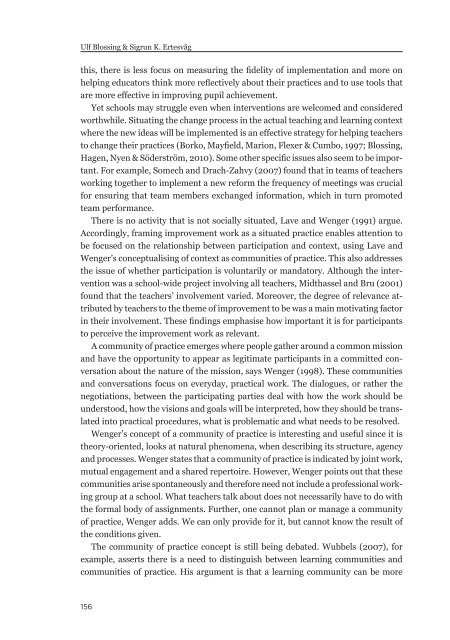Download issue - Umeå universitet
Download issue - Umeå universitet
Download issue - Umeå universitet
You also want an ePaper? Increase the reach of your titles
YUMPU automatically turns print PDFs into web optimized ePapers that Google loves.
Ulf Blossing & Sigrun K. Ertesvåg<br />
this, there is less focus on measuring the fidelity of implementation and more on<br />
helping educators think more reflectively about their practices and to use tools that<br />
are more effective in improving pupil achievement.<br />
Yet schools may struggle even when interventions are welcomed and considered<br />
worthwhile. Situating the change process in the actual teaching and learning context<br />
where the new ideas will be implemented is an effective strategy for helping teachers<br />
to change their practices (Borko, Mayfield, Marion, Flexer & Cumbo, 1997; Blossing,<br />
Hagen, Nyen & Söderström, 2010). Some other specific <strong>issue</strong>s also seem to be important.<br />
For example, Somech and Drach-Zahvy (2007) found that in teams of teachers<br />
working together to implement a new reform the frequency of meetings was crucial<br />
for ensuring that team members exchanged information, which in turn promoted<br />
team performance.<br />
There is no activity that is not socially situated, Lave and Wenger (1991) argue.<br />
Accordingly, framing improvement work as a situated practice enables attention to<br />
be focused on the relationship between participation and context, using Lave and<br />
Wenger’s conceptualising of context as communities of practice. This also addresses<br />
the <strong>issue</strong> of whether participation is voluntarily or mandatory. Although the intervention<br />
was a school-wide project involving all teachers, Midthassel and Bru (2001)<br />
found that the teachers’ involvement varied. Moreover, the degree of relevance attributed<br />
by teachers to the theme of improvement to be was a main motivating factor<br />
in their involvement. These findings emphasise how important it is for participants<br />
to perceive the improvement work as relevant.<br />
A community of practice emerges where people gather around a common mission<br />
and have the opportunity to appear as legitimate participants in a committed conversation<br />
about the nature of the mission, says Wenger (1998). These communities<br />
and conversations focus on everyday, practical work. The dialogues, or rather the<br />
negotiations, between the participating parties deal with how the work should be<br />
understood, how the visions and goals will be interpreted, how they should be translated<br />
into practical procedures, what is problematic and what needs to be resolved.<br />
Wenger’s concept of a community of practice is interesting and useful since it is<br />
theory-oriented, looks at natural phenomena, when describing its structure, agency<br />
and processes. Wenger states that a community of practice is indicated by joint work,<br />
mutual engagement and a shared repertoire. However, Wenger points out that these<br />
communities arise spontaneously and therefore need not include a professional working<br />
group at a school. What teachers talk about does not necessarily have to do with<br />
the formal body of assignments. Further, one cannot plan or manage a community<br />
of practice, Wenger adds. We can only provide for it, but cannot know the result of<br />
the conditions given.<br />
The community of practice concept is still being debated. Wubbels (2007), for<br />
example, asserts there is a need to distinguish between learning communities and<br />
communities of practice. His argument is that a learning community can be more<br />
156

















